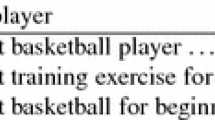Abstract
A web-based search engine responds to a user’s query with a list of documents. This list can be viewed as the engine’s model of the user’s idea of relevance—the engine ‘believes’ that the first document is the most likely to be relevant, the second is slightly less likely, and so on. We extend this idea to an interactive setting where the system accepts the user’s feedback and adjusts its relevance model. We develop three specific models that are integrated as part of a system we call Lighthouse. The models incorporate document clustering and a spring-embedding visualization of inter-document similarity. We show that if a searcher were to use Lighthouse in ways consistent with the model, the expected effectiveness improves—i.e., the relevant documents are found more quickly in comparison to existing methods.
Similar content being viewed by others
References
Aalbersberg, I. J.: 1992, Incremental relevance feedback. In: Proceedings of ACM SIGIR. pp. 11–22.
Allan, J.: 1995, Automatic Hypertext Construction. Ph.D. thesis, Cornell University.
Allan, J., Callan, J., Croft, B., Ballesteros, L., Broglio, J., Xu, J. and Shu, H.: 1997, ‘INQUERY at TREC-5’. In: Fifth Text REtrieval Conference (TREC-5). pp. 119–132.
Allan, J., Callan, J., Croft, W.B., Ballesteros, L., Byrd,D., Swan, R. and Xu, J.: 1998, INQUERY does battle with TREC-6. In: Sixth Text REtrieval Conference (TREC-6). pp. 169–206.
Benyon, D. and Murray, D.: 1993, Developing adaptive systems to fit individual needs. In: Proceedings of the 3rd International Workshop on Intelligent User Interfaces. pp. 115–121.
Berliner, H.: 1979, On the construction of evaluation functions for large domains. In: Proceedings of the Sixth International Joint Conference on Artificial Intelligence.
Bookstein, A.: 1983, Information retrieval: A sequential learning process. Journal of the American Society for Information Science 34(5), 331–342.
Buckley, C. and Salton, G.: 1995, Optimization of relevance feedback weights. In: Proceedings of ACM SIGIR. pp. 351–357.
Chalmers, M. and Chitson, P.: 1992, Bead: Explorations in information visualization. In: Proceedings of ACM SIGIR. pp. 330–337.
Chen, H.: 1995,Machine learning for information retrieval: Neural networks, symbolic learning, and genetic algorithms. Journal of the American Society for Information Science 46(3), 194–216.
Chen, J. R. and Mathe, N.: 1995, Learning subjective relevance to facilitate information access. In: CIKM. pp. 218–225.
Cypher, A.: 1991, Programming repetitive tasks by example. In: Proceedings of the ACM Conference on Computer Human Interaction. pp. 33–39.
Frey, D., Gupta, R., Khandelwal, V., Lavrenko, V., Leuski, A. and Allan, J.: 2001, Monitoring the news: a TDT demonstarion system. In: Proceedings of the first International HLT Conference.
Frisse, M. E. and Cousing, S. B.: 1989, Information retrieval from hypertext: Update on the dynamic medical handbook project. In: Proceedings of the ACM Conference on Hypertext. pp. 199–212.
Fruchterman, T. M. J. and Reingold, E. M.: 1991, Graph drawing by force-directed placement. Software-Practice and Experience 21(11), 1129–1164.
Harman, D. and Voorhees, E. (eds.): 1997, The Fifth Text REtrieval Conference (TREC-5). NIST.
Harman, D. and Voorhees, E. (eds.): 1998, The Sixth Text REtrieval Conference (TREC-6). NIST.
Harman, D. and Voorhees, E. (eds.): 1999, The Eighth Text REtrieval Conference (TREC-8). NIST.
Harman, D. and Voorhees, E. (eds.): 2000, The Ninth Text REtrieval Conference (TREC-9). NIST.
Harman, D. and Voorhees, E. (eds.): 2001, The Tenth Text REtrieval Conference (TREC-2001). NIST.
Hearst, M. A. and Pedersen, J. O.: 1996, Reexamining the cluster hypothesis: Scatter/Gather on retrieval results. In: Proceedings of ACM SIGIR. pp. 76–84.
Hersh, W. and Over, P.: 2001, The TREC-9 interactive track report. In: The Ninth Text REtrieval Conference (TREC-9). pp. 41–50.
Koenemann, J. and Belkin, N. J.: 1996, A case for interaction: A study of interactive information retrieval behavior and effectivness. In: Proceedings of ACM SIGCHI Conference on Human Factors in Computing Systems. pp. 205–212.
Lance, G. N. and Williams, W. T.: 1967, A general theory of classificatory sorting strategies: 1. Hierarchical Systems. Computer Journal 9, 373–380.
Leuski, A.: 2000, Relevance and reinforcement in interactive browsing. In: Proceedings of Ninth International Conference on Information and KnowledgeManagement (CIKM’00). pp. 119–126.
Leuski, A.: 2001a, Evaluating document clustering for interactive information retrieval. In: Proceedings of Tenth International Conference on Information and Knowledge Management (CIKM’00). pp. 41–48.
Leuski, A.: 2001b, Interactive Information Organization: Techniques and Evaluation. Ph.D. thesis, University of Massachusetts at Amherst.
Leuski, A. and Allan, J.: 2000a, Details of Lighthouse. Technical Report IR-212, Department of Computer Science, University of Massachusetts, Amherst.
Leuski, A. and Allan, J.: 2000b, Lighthouse: showing the way to relevant information. In: Proceedings of InfoVis’2000.
Leuski, A. and Croft, W. B.: 1996, An Evaluation of Techniques for Clustering Search Results. Technical Report IR-76, Department of Computer Science, University of Massachusetts, Amherst.
Lewis, D. D.: 1992, An evaluation of phrasal and clustered representations on a text categorization task. In: Proceedings of ACM SIGIR. pp. 37–50.
Mirkin, B.: 1996, Mathematical Classification and Clustering. K luwer.
Robertson, S. E., Walker, S., Jones, S., Hancock-Beaulieu, M. M. and Gatford M.: 1995, Okapi at TREC-3. In: D. Harman and E. Voorhees (eds.): Third Text REtrieval Conference (TREC-3).
Rocchio, Jr., J. J.: 1971, Relevance feedback in information retrieval. In: G. Salton (ed.): The SMART Retrieval System: Experiments in Automatic Document Processing. Prentice-Hall, Inc., pp. 313–323.
Salton, G.: 1989, Automatic Text Processing. Addison-Wesley.
Sullivan, J. W. and Tyler, S. W. (eds.): 1991, Intelligent User Interfaces. ACM.
Swan, R. and Allan, J.: 1998, Aspect Windows, 3-D Visualizations, and indirect comparisons of information retrieval systems. In: Proceedings of ACM SIGIR. pp. 173–181.
van Rijsbergen, C. J.: 1979, Information Retrieval. London: Butterworths. Second edition.
Xu, J. and Croft, W. B.: 1996, Querying expansion using local and global document analysis. In: Proceedings of ACM SIGIR. pp. 4–11.
Author information
Authors and Affiliations
Rights and permissions
About this article
Cite this article
Leuski, A., Allan, J. Interactive Information Retrieval Using Clustering and Spatial Proximity. User Model User-Adap Inter 14, 259–288 (2004). https://doi.org/10.1023/B:USER.0000028978.09823.47
Issue Date:
DOI: https://doi.org/10.1023/B:USER.0000028978.09823.47




